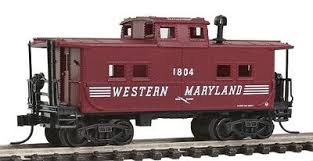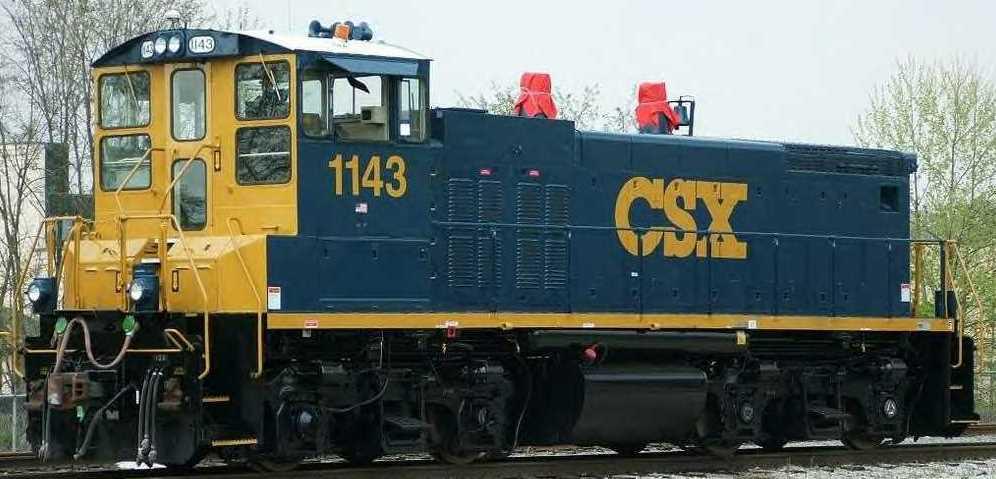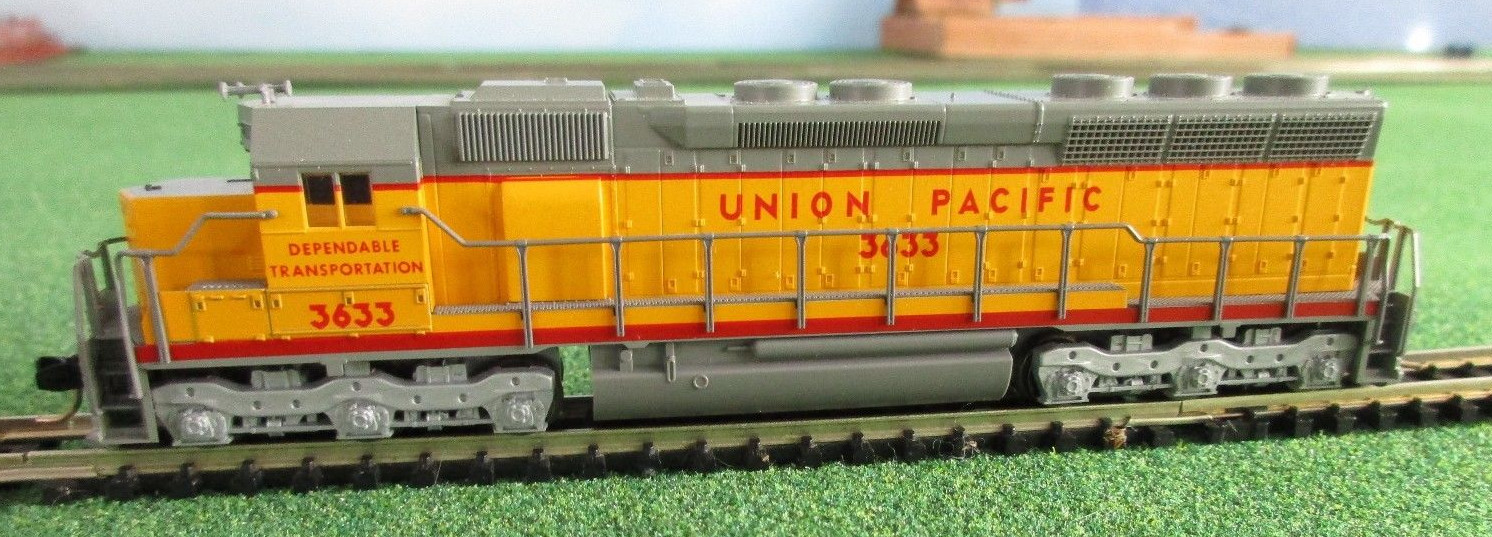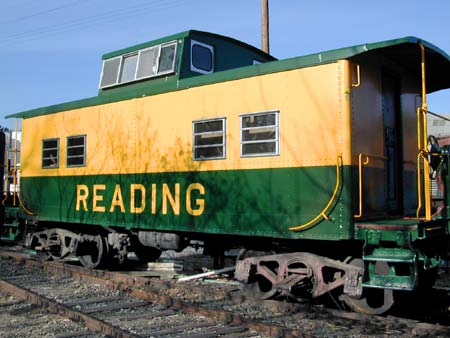Model Information: Life-Like first introduced this body style in the 90's. They have metal wheels and truck-mounted Rapido couplers. The caboose design is based on a common prototype used by many Northeastern roads.
Prototype History: The Northeast or NE style caboose was introduced by the Reading Railroad in 1924. The design was an all-steel version of a USRA design. The acquisition of these new cabooses was prompted by proposed Pennsylvania legislation requiring larger, more structurally sound caboose for use in through freight consists. The original set of cabooses was ordered from AC&F, but other manufacturers also adopted similar designs.
The Reading selection was made after the consideration of several designs. The original purchase was for 10 cars in 1924, but the design was so effective that it became the de-facto Reading standard and they continued purchasing new cabooses of this type through 1948. The design soon became popular with other Northeastern railroads such as the WM, L&NE, LV, CNJ and others.
The Reading selection was made after the consideration of several designs. The original purchase was for 10 cars in 1924, but the design was so effective that it became the de-facto Reading standard and they continued purchasing new cabooses of this type through 1948. The design soon became popular with other Northeastern railroads such as the WM, L&NE, LV, CNJ and others.
Road Name History: This line was established in 1852 under another name but was renamed Western Maryland Rail Road before the first rail was laid. By 1862 they had built from Baltimore to Union Bridge, Maryland at which point it became the responsibility of the Union Army. Construction resumed after the war. WM built west to Hagerstown then Cumberland where the line spilt in two. One route headed northwest to an important interchange with Pittsburgh & Lake Erie at Connellsville, Pennsylvania. The other line ran southwest into the rich coal fields around Elkins and Durban, West Virginia. On the east end, they also had routes to York and Gettysburg and an important connection with the Reading at Shippensburg, all in Pennsylvania. At 878 miles, WM was between Maine Central and Spokane Portland & Seattle in relative length.
The city of Baltimore had a large stake in the WM but sold it in 1902 to Jay Gould. The Gould empire unraveled just six years later and the WM was reorganized with Railway replacing Rail Road in the name and John D. Rockefeller holding a 43% stake. He sold those shares to Baltimore & Ohio in 1927. Accused of violating antitrust laws, B&O placed those shares in a non-voting trust.
After 1900, WM relied heavily on 2-8-0’s, ordering 177 between 1900 and 1923 (by which time other railroads were already ordering 2-8-2’s.) Some of these Consolidations were real bruisers with the same tractive effort as WM’s 2-6-6-2’s. Also in road service were 30 2-10-0 Decapods (10 Russian Decapods and 20 much larger versions,) a dozen 4-8-4’s to handle the high speed trains, and a dozen 4-6-6-4 Challengers. The Challengers turned out to be a disappointment to WM. They were rough riders and were hard on the track. As a result, they were soon demoted to pusher service alongside WM’s 25 2-8-8-2’s. A fleet of 19 low drivered Pacifics handled most of the passenger assignments. One element found on most of the WM steam fleet was low snowplow pilots in lieu of the traditional boiler tube pilots. WM was one of a few Class One railroads to employ Shay locomotives to serve steeply graded branchlines. WM had one 2-truck, two 3-truck and two 4-truck Shays. Shay #6 built in 1945 was the last Shay built by Lima Locomotive Works.
WM began to dieselize in 1947 on the east end where they would not raise the ire of their coal mining customers on the west end. The diesel fleet was surprisingly varied for a line their size with cab units from both Alco and EMD, road switchers from Alco, EMD and Baldwin and yard switchers from GE, Baldwin and Alco. The road switchers from Alco and Baldwin plus the EMD GP7;s were delivered with the long hood as the front while the EMD GP9’s were delivered with the short hood as the front. The Second Generation of diesels was all EMD.
In addition to the voluminous coal traffic, WM was a part of two bridge routes for merchandise moving between the northeast and the upper Midwest. These were the Alphabet Route (with Nickel Plate Road, Wheeling & Lake Erie, Pittsburgh & West Virginia, Reading and others) and the Central States Dispatch (with Baltimore & Ohio, Reading, Jersey Central, Lehigh & Hudson River and New Haven.) Iron ore also moved from Baltimore area ports to steel mills on the connecting P&LE.
Passenger service was a bit of an afterthought on the WM. Not only did they not have a shiny streamliner, but their heavyweight coach trains lasted only until 1957 before being discontinued. Steam generator equipped hammerhead RS-3’s replaced the Pacifics in passenger service for a few years before being reassigned to freight duty.
In 1967, B&O (by this time controlled by Chesapeake & Ohio) finally obtained permission to take overt control of the WM. Not much changed for the next five years. In 1973 they adopted the Chessie System image and 125 miles of WM mainline was abandoned in favor of trackage rights on a parallel B&O line. In 1983, the Western Maryland was absorbed into the Baltimore & Ohio. Western Maryland was known for frequently washing their locomotives in both the steam and diesel eras. They kept up this tradition until the start of the Chessie System era.
The city of Baltimore had a large stake in the WM but sold it in 1902 to Jay Gould. The Gould empire unraveled just six years later and the WM was reorganized with Railway replacing Rail Road in the name and John D. Rockefeller holding a 43% stake. He sold those shares to Baltimore & Ohio in 1927. Accused of violating antitrust laws, B&O placed those shares in a non-voting trust.
After 1900, WM relied heavily on 2-8-0’s, ordering 177 between 1900 and 1923 (by which time other railroads were already ordering 2-8-2’s.) Some of these Consolidations were real bruisers with the same tractive effort as WM’s 2-6-6-2’s. Also in road service were 30 2-10-0 Decapods (10 Russian Decapods and 20 much larger versions,) a dozen 4-8-4’s to handle the high speed trains, and a dozen 4-6-6-4 Challengers. The Challengers turned out to be a disappointment to WM. They were rough riders and were hard on the track. As a result, they were soon demoted to pusher service alongside WM’s 25 2-8-8-2’s. A fleet of 19 low drivered Pacifics handled most of the passenger assignments. One element found on most of the WM steam fleet was low snowplow pilots in lieu of the traditional boiler tube pilots. WM was one of a few Class One railroads to employ Shay locomotives to serve steeply graded branchlines. WM had one 2-truck, two 3-truck and two 4-truck Shays. Shay #6 built in 1945 was the last Shay built by Lima Locomotive Works.
WM began to dieselize in 1947 on the east end where they would not raise the ire of their coal mining customers on the west end. The diesel fleet was surprisingly varied for a line their size with cab units from both Alco and EMD, road switchers from Alco, EMD and Baldwin and yard switchers from GE, Baldwin and Alco. The road switchers from Alco and Baldwin plus the EMD GP7;s were delivered with the long hood as the front while the EMD GP9’s were delivered with the short hood as the front. The Second Generation of diesels was all EMD.
In addition to the voluminous coal traffic, WM was a part of two bridge routes for merchandise moving between the northeast and the upper Midwest. These were the Alphabet Route (with Nickel Plate Road, Wheeling & Lake Erie, Pittsburgh & West Virginia, Reading and others) and the Central States Dispatch (with Baltimore & Ohio, Reading, Jersey Central, Lehigh & Hudson River and New Haven.) Iron ore also moved from Baltimore area ports to steel mills on the connecting P&LE.
Passenger service was a bit of an afterthought on the WM. Not only did they not have a shiny streamliner, but their heavyweight coach trains lasted only until 1957 before being discontinued. Steam generator equipped hammerhead RS-3’s replaced the Pacifics in passenger service for a few years before being reassigned to freight duty.
In 1967, B&O (by this time controlled by Chesapeake & Ohio) finally obtained permission to take overt control of the WM. Not much changed for the next five years. In 1973 they adopted the Chessie System image and 125 miles of WM mainline was abandoned in favor of trackage rights on a parallel B&O line. In 1983, the Western Maryland was absorbed into the Baltimore & Ohio. Western Maryland was known for frequently washing their locomotives in both the steam and diesel eras. They kept up this tradition until the start of the Chessie System era.
Brand/Importer Information: Wm. K. Walthers, Inc., was founded in Milwaukee in 1932 -- but really, it started years earlier, when seven-year-old Bill Walthers got his first taste of the hobby with a small, wind-up toy train for Christmas. He continued with the hobby and eventually had an attic layout comprised primarily of his own scratch-built creations. After he wrote a series of articles on building train control and signaling systems, he got so many letters from other modelers that he began manufacturing them. The first ad (in the May issue of The Model Maker) offered a 24-page, 15c catalog that listed rail, couplers, and electrical supplies. Sales were over $500.00 for the first year, and the fledgling company was off to a strong start.
Within five years, Walthers had grown so much that larger quarters were needed. Space was found on Erie Street, where everything -- from milled wood parts to metal castings to decals -- was made in-house. 1937 also saw a new line in HO Scale, featured in its own catalog. Bill brought operating layouts to the 1939 World's Fair, which gave the hobby a big boost. Soon, though, the growing possibility of war overshadowed these successes, and supplies were becoming increasingly difficult to obtain.
During the war, model manufacturers were ordered to stop production in order to conserve critical metal supplies. Walthers produced what it could from nonessential materials. A series of ads in 1943 saw Bill literally scraping the bottom of a barrel! The postwar boom meant rapid growth for the hobby; however, small homes and new families left no room for O scale layouts, and many modelers moved to HO Scale.
The next twenty years brought great change. In 1958, Bill retired and his son Bruce took over. Just as full-size railroads were being hard-hit by new technology, so too were model railroads. Leisure time was spent in front of the TV set, not the train set. In 1960, Walthers became a full-line distributor of other manufacturers' products while continuing expansion of the Walthers lines. By the start of the 1970's, business was booming again, and Bruce's son Phil joined the company.
Expansion and diversification continue under Phil's tenure. The establishment of the Walthers Importing Division added several international lines. The manufacturing plant was modernized. Code 83 track was introduced in 1985, giving layouts more realistic proportions. In 1990, the Cornerstone Series buildings were unveiled. Combining a freight car with a related industry, the Cornerstone Series makes it possible for modelers to duplicate authentic operations, enhancing layout realism. The Train Line Deluxe Sets and locomotives debuted in 1994. These sets feature the detailing of serious models and an affordable price -- allowing newcomers to get started, and then build-on to their first set, rather than replacing it.
In 2005, Walthers purchased Life-Like from Lifoam Industries. With this purchase Walthers acquired the Proto Lines that have become the backbone of their locomotive and rolling stock segments.
Today, Walthers continues to expand, improve and develop a wide range of products. Their latest selection can be found throughout Walthers.com and their printed catalogs, along with items from over 300 other manufacturers.
In December 2017, Lowell Smith announced the ‘purchase of tooling’ of the Walthers line of N Scale passenger cars (sleeper, coach and baggage cars), and in June 2018, Atlas announced that it will purchase all N scale locomotive and rolling stock tooling owned by Walthers, including the Walthers N tooling as well as former Life-Like tooling. This divestment puts an end to Walthers involvement as a manufacturer of N scale rolling-stock, though it will continue its range of N scale structures.
Within five years, Walthers had grown so much that larger quarters were needed. Space was found on Erie Street, where everything -- from milled wood parts to metal castings to decals -- was made in-house. 1937 also saw a new line in HO Scale, featured in its own catalog. Bill brought operating layouts to the 1939 World's Fair, which gave the hobby a big boost. Soon, though, the growing possibility of war overshadowed these successes, and supplies were becoming increasingly difficult to obtain.
During the war, model manufacturers were ordered to stop production in order to conserve critical metal supplies. Walthers produced what it could from nonessential materials. A series of ads in 1943 saw Bill literally scraping the bottom of a barrel! The postwar boom meant rapid growth for the hobby; however, small homes and new families left no room for O scale layouts, and many modelers moved to HO Scale.
The next twenty years brought great change. In 1958, Bill retired and his son Bruce took over. Just as full-size railroads were being hard-hit by new technology, so too were model railroads. Leisure time was spent in front of the TV set, not the train set. In 1960, Walthers became a full-line distributor of other manufacturers' products while continuing expansion of the Walthers lines. By the start of the 1970's, business was booming again, and Bruce's son Phil joined the company.
Expansion and diversification continue under Phil's tenure. The establishment of the Walthers Importing Division added several international lines. The manufacturing plant was modernized. Code 83 track was introduced in 1985, giving layouts more realistic proportions. In 1990, the Cornerstone Series buildings were unveiled. Combining a freight car with a related industry, the Cornerstone Series makes it possible for modelers to duplicate authentic operations, enhancing layout realism. The Train Line Deluxe Sets and locomotives debuted in 1994. These sets feature the detailing of serious models and an affordable price -- allowing newcomers to get started, and then build-on to their first set, rather than replacing it.
In 2005, Walthers purchased Life-Like from Lifoam Industries. With this purchase Walthers acquired the Proto Lines that have become the backbone of their locomotive and rolling stock segments.
Today, Walthers continues to expand, improve and develop a wide range of products. Their latest selection can be found throughout Walthers.com and their printed catalogs, along with items from over 300 other manufacturers.
In December 2017, Lowell Smith announced the ‘purchase of tooling’ of the Walthers line of N Scale passenger cars (sleeper, coach and baggage cars), and in June 2018, Atlas announced that it will purchase all N scale locomotive and rolling stock tooling owned by Walthers, including the Walthers N tooling as well as former Life-Like tooling. This divestment puts an end to Walthers involvement as a manufacturer of N scale rolling-stock, though it will continue its range of N scale structures.
Item created by: Alain LM on 2019-07-21 09:18:23. Last edited by CNW400 on 2020-05-19 14:11:17
If you see errors or missing data in this entry, please feel free to log in and edit it. Anyone with a Gmail account can log in instantly.
If you see errors or missing data in this entry, please feel free to log in and edit it. Anyone with a Gmail account can log in instantly.











